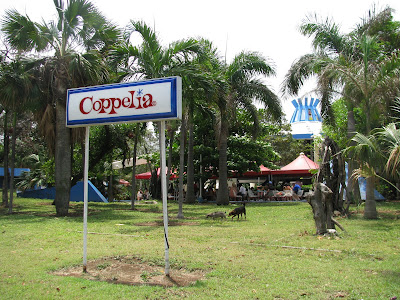Castro’s vision was a state-run ice cream parlour that would serve a minimum of 32 flavours. In 1959, Coppelia (the word means “ice cream parlour”) replaced all the privately run ice cream shops that the country’s leader considered “highly discriminatory”. Ice cream is not just for the elite, Castro said.
Today, it’s estimated that Coppelia serves 25,000 patient customers daily who, on average, wait two hours just for a few scoops.
So of course, we made our way to the much-talked about ice cream spot.
When we first walked up to Coppelia, it looked like a big park. It was roughly the size of a city block, but it was landscaped with trees and paths, so it looked bigger. There was a little ice cream stand with some tables on the outer edge, but we knew that this surely could not be the place that our book said served up to 25,000 customers a day.
So we followed a path that took us to the other side of the park. There we found a crowded two-level complex with an indecipherable system of lines and seating. On the lower level, people were sitting on stools and eating at a long crescent-shaped bar. Built over the bar area was a large concrete structure with big windows and more seating.We stood there for a minute, trying to figure out the system, until a guard approached us. Between his broken English and my extremely poor Spanish, I told him that we wanted ice cream. He told us that the ice cream for us was around on the other side of the park, at that first stand we had seen.
I was confused. He explained that this crowded complex was for people who paid with "moneda nacional" (literally, national money), in other words, for people who paid with Cuban pesos. The little stand on the other side of the park was for people who paid with dollars, although not Cdn or US dollars, but the CUC (Cuban Convertible Pesos) that the tourists use and receive from the banks and money exchange places. It's quite a confusing system.
As we made our way back towards the stand on the other side of the park, we passed more people waiting for ice cream. They lined the sidewalk outside of the park.It made a little more sense later when I talked some other people about it. It turns out that Coppelia was built in the 1960s to replace Howard Johnson's, the North American ice cream that Cubans had once enjoyed. Waiting in line on a Saturday or Sunday afternoon was actually considered a pleasant way to pass the day. People would meet up with their friends, run into people they hadn't seen in awhile, and at the end of an enjoyable afternoon, they would sit down to some ice cream. Many of them brought various containers, from ice-cream bucket size to small single size tupperware style, getting ice cream to take home. The dish in the picture (2 scoops, cake and a cookie) is about .20, of the nacional peso, which I think is about 5 cents Cdn. Casto really did well with his "ice cream for everyone."
Anyhow, we were standing looking lost, and a guard told us we could go order, and eat some ice-cream in one of the stands for the locals, so we did. Basically we just sat down and we must have looked confused because a nice fellow came over and took our order for us, and all was well. And the ice-cream was delicious!




No comments:
Post a Comment